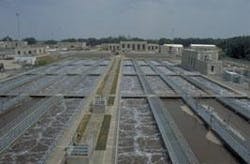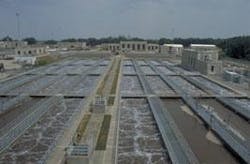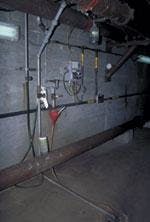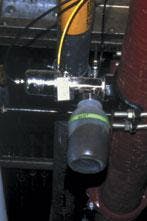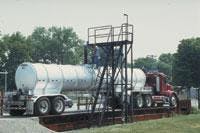Automatic sampling helps upgrade sludge processing
By Craig Johnson
The Jackson Pike wastewater treatment plant in Columbus, Ohio, USA, launched a plan nearly ten years ago to upgrade its solids processing system by switching from two-stage to single-stage digestion.
This change, aided by the industry's first large-scale installation of multi-port sliding valve mixers, plus improved heating and continuous sludge feeding, required only six digesters to do the work that required 16 digesters under the earlier two-stage process. However, boosting the new system to peak efficiency ultimately depended on finding the right recipe. After six years of experimenting, with the help of automatic sampling, Jackson Pike found the key to fine-tuning its new system, reduced costs and nearly eliminated the plant's most time-consuming task - sampling.
The biological treatment plant processes 80 million gallons of wastewater daily. Anaerobic digestion then treats sludge harvested from primary and secondary clarifiers (settling tanks). About 15% of the resulting digested biosolids is dewatered by centrifuges to 10% solids and hauled away in tank trucks — as much as 40 loads per week — for use as fertiliser injected into farmland soil. The remaining 85% is centrifuged to 20% solids and incinerated, producing ash that can be recycled.
Assistant Plant Manager Doug Wise noted that approximately 70% of total plant cost is spent on solids removal, so maximising efficiency on this operation is especially important for over-all cost containment. "Digesting sludge reduces its solids volume by more than half, so there's much less to incinerate," he explained. "It also increases the concentration of nutrients, nitrogen, phosphorus and potassium, making it ideal for land application as a soil amendment."
Bringing new digesters up to peak performance was a complicated issue, he continued, because two different kinds of sludge are digested together. Sludge from the primary clarifiers comprises a mixture of the denser organic and inert matter, while sludge from the secondary treatment process is a lighter, fluffier, biologically active material.
Most of this activated sludge is returned to the secondary aeration tanks to treat the wastewater. The excess that isn't returned — called Waste Activated Sludge (WAS) — is removed from the treatment process for disposal, but direct disposal of WAS is a problem. It can't go directly to incineration because its volume and high water content would require high temperatures and/or longer burn times, resulting in unacceptably high fuel costs. It cannot readily be dewatered by centrifuges above 15% solids because its water content is largely bound up inside live bacteria and microorganisms. This low solids content makes it undesirable for and costly to haul to the landfill. Primary sludge, by contrast, easily dewaters above 20%.
"In order to incinerate WAS as economically as possible," he pointed out, "we need to put it through digestion first, not only to reduce its volume, but also to kill the live organisms and allow fuller dewatering. Having already made the major commitment to single-stage digestion, our big challenge then was to maximise WAS digestion using the plant as-is, without any substantial equipment changes."
Wise recalled that primary sludge and WAS initially were piped to a common mixing vessel and whatever blend occurred there was fed to the digesters. "Sometimes it worked well and sometimes it didn't," he said, "but we didn't know when it would or wouldn't, or why."
Simplifying an explanation, Wise pointed out that primary sludge is digested readily but WAS takes more time to break down due to its complexity. "We get highest efficiency when the solids ratios in both sludges are correctly balanced so digestion of both components will be completed at the same time."
Photot by Bristol Equipment Company
"Our first step toward learning how this works," he continued, "was to re-route the two sludges into separate holding tanks so we could vary the mixture and study how different solids ratios affect digestion. Then we experimented with many different blends of WAS and primary sludge, also trying them on different types of anaerobic digestion to see what technology would work best with our plant equipment. For that reason we needed to draw and test a lot of samples. "
Employees gathered samples throughout the plant every two hours by a simple but messy process - turn a spigot, fill a cup and dump it into a jar to build up a 24-hour composite sample for analysis. "With about twenty-eight sampling points in our sludge handling stream, this became the most time-consuming aspect of our work," he observed. "It's also stinky and sloppy, because when you open a line under pressure, the sludge just shoots out, especially at those spigots installed in pump volutes where pressure is greatest. You can't just crack the spigot open a little, or the sample just gets the thin liquid part — not a true representative grab of the solids."
"After several years of experiments based on manual sampling," he continued "we began to realise that reaching an accurate conclusion would require more latitude in blending the digester input, with more reliable sampling of the material going into and coming out of the digesters." A blending manifold was built to allow three pumps on the primary sludge and WAS lines to feed a pipeline to the digesters or and/or a pipeline bypassing the digesters. Used simultaneously or in selective combinations, three pumps would allow very fine control over the proportions of both sludges going into the blend.
The plant staff used automatic Isolok® samplers built by Bristol Equipment Company, located in Yorkville, Illinois, USA, to assess the material moving through the system — two on lines coming out of the primary sludge and WAS holding tanks leading to the manifold, two on the digester infeed and bypass lines leaving the manifold, and one on the line from the digesters to the centrifuges, downstream from where any bypass material would join the digester outflow. "With that setup," Wise said, "no matter what mix we put together or where we send it, we can accurately monitor solids content."
Isolok samplers mount onto an access port installed in the side of a pipeline, tank or pressure vessel. The sampler body encloses a plunger positioned to extend through the port and into the process stream when activated by a pneumatic cylinder.
Near the plunger's tip is an annular ring termed the sample spool, which is sized to capture a measured volume of process material by positive displace-ment in this application, 8 cc per cycle. When the spool darts into the product stream, then withdraws, it brings out a sample of process material flowing past it at that time, and drops the sample into a closed container attached beneath the sampler body.
Heavy elastomer seals around the plunger at both ends of the spool keep the port closed regardless of plunger position, and the sample remains contained within the sampler body until discharged, so there is never any outpouring of process material contaminating workers or requiring cleanup.
A control panel provided by Bristol pneumatically actuates the samplers. Cycle time, user-programmed within the panel, was set at six minutes to gather enough 8-cc samples to nearly fill a two-litre bottle within a 24-hour time span. The panel also directs a pulse of compressed air through a port above each sampler's discharge opening to eject any sluggish material within the sample. The eject air enters through a special three-way valve that doubles as a flushing device. When the valve handle is turned 180º, the air line is blocked and water is allowed to wash through the sampler body to clean out any residual build-up inside.
"Automatic sampling done consistently every six minutes obviously produces a much more reliable composite than manual sampling done inconsistently every two hours," Wise pointed out. "It also reduces labour costs considerably." According to a Jackson Pike management team, the seven samplers installed in the plant save more than US$ 81,000 per year in labour costs. Each automatic sampler requires an operator visit only once a day to harvest the composite sample.
The blending manifold and sampling system made possible closely controlled variations, so plant staff was able to explore alternative technologies of thermophillac digestion and acid fermentation while testing a wide range of blend ratios. Finally, they determined that although better ways are available, the standard mesophillac digestion used previously — and widely used throughout the industry — works best with the digesters now in place if controlled properly.
"For our system," Wise concluded, "we now know we must keep the sludge solids content balanced by weight at 30% WAS to 70% primary sludge. Any more than 30% WAS makes the digesters start to get sick. Any less WAS lets the system fall off peak efficiency. Continual sampling and testing gives us the tools to keep the system tightly controlled."
Authors' NoteCraig Johnson works for Bristol Equipment Company, located in Yorkville, Illinois, USA. The author wishes to extend his sincere appreciation to Douglas Wise of the City of Columbus' Public Utilities Department for his significant contributions to this article. For more information, contact Myron Feldman, vice president of sales for Sentry Equipment Corporation, which acquired Bristol Equipment in 2003. Email:[email protected].
